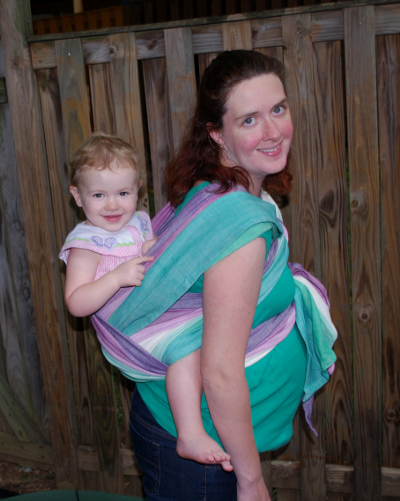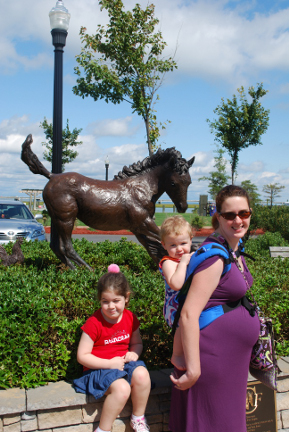Choosing a coat & choosing fleece:
The coat I chose was a down coat, two sizes larger than what I normally wear. I found it at our local thrift
How big should the opening be?
I made my opening 23 cm x 57 cm, and measured down only 12 cm from the back seam of the jacket.
My coat had a slippery lining, and I had to pin the two layers carefully together, then run two (not one) lines of basting before I started zigzagging. THIS IS VERY IMPORTANT. OTHERWISE YOU WILL HAVE A MILLION FEATHERS EVERYWHERE!! A helpful hint if you’re using a down coat, try to create a “valley” in the down so that your stitching and subsequent cuts will only have to go through the fabrics layers of the coat, not through feathers.
Carefully zigzag two lines of stitching, one on either side of the basting line. Make sure not to overlap the two lines of zigzagging, since you’ll be cutting between them.
Carefully cut between the two lines of zigzagging. This will leave you with a coat that has a 3-sided flap cut out, STILL CONNECTED along the bottom edge.
Vertical fleece inserts:
To cut your fleece, fold it so that the stretch goes perpendicular to the fold. Cut TWO of these pieces. (Note that it’s cut on the fold so that the insert is a DOUBLE LAYER of fleece!) The piece should be a total of 61 cm long (draw the curve, starting 9 cm from the bottom), and 13 cm wide. I drew the curve freehand, which worked fine. (Then, to make sure the curves matched, I used the first piece I cut as a template for the second.)
Zigzag the open edges of the folded fleece piece together. Make sure the right side of the fleece is facing out! (This makes it tons easier to deal with.)
Match right sides of the fleece insert and the coat together, lining up the curved side of the fleece piece with the CENTER of the coat flap you’ve cut. (I.e., the curved side of the fleece will be sewn to the flap, while—eventually—the straight edge will be sewn to the main part of the coat.) NOTE: make sure when you line up the bottom of the fleece piece that there’s not going to be a gap once its sewn—i.e., you need to scootch the fleece piece down maybe 5mm to allow for a seam allowance at the bottom edge.
Sew the flap and the fleece piece together, with about a 6mm seam allowance.
Trim off any of the fleece piece that rises above the flap.
Do the same with the second side.
Fleece across the top of the flap:
The next piece you’ll cut and sew is the fleece piece that goes across the top of the flap. With the stretch of the fabric going in the SAME DIRECTION as the fold, fold your fleece. Cut a piece that’s 9 cm by 47 cm. Zigzag the edges of the fleece together for easier handling. Matching right sides together, sew the fleece piece along the top edge of the flap.
BEFORE you do, pin it in place and give the whole thing a quick eyeball to make sure the flap is the right length to go up just a little beyond the top cut in the main body of the coat.
This is where I added the faux fur flap. I used the same measurements as the fleece piece above. It is just essentially a decorative cover.
Lining the raw edge on the inside of the pocket:
The next piece is the fleece that will line the inside of the opening at the top. With the stretch going long ways (and NOT cut on the fold), cut a piece that’s 5 cm by 24 cm
With right sides together (i.e., right side of the fleece with outside of the jacket), line up the edge of the cut along the top of the coat with the fleece piece. Fold over and pin 6mm at each side. Sew right along this edge. Then fold the piece of fleece around the raw edge of the coat/fleece seam to the inside of the coat. Pin it in place, and sew right on the original line of stitching. (you may need to fiddle a tiny bit to hide the seam allowances on the edges.) This makes a really nice soft edge for your baby’s face.
Putting it all together:
Matching ride sides together, line up and pin the flap to the coat body.
Starting from the bottom, sew, leaving a bare 3 mm seam allowance. Makes sure to catch the raw edges at the top. I ended up doing a little top stitching at the top corners to reinforce the connection.
The only thing that I would add would be a drawstring of some sort to adjust the opening of the pouch along the top rail. Sometimes I could feel the cold air coming in, and that just defies the whole purpose of us wearing a coat!
The finished coat:
Other links to DIY Babywearing coats:
http://www.sedlmeiers.net/photos/Babywearing/BabywearingCoat/instructions.html
http://www.kiddiesgames.com/jacketinserts/
Posted by Angelique





